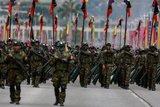Iraq requests AN/TPQ-36(V)10 FIREFINDER radars
The Defense Security Cooperation Agency notified Congress today of a possible Foreign Military Sale to the Government of Iraq of six AN/TPQ-36(V)10 FIREFINDER Radar Systems, 18 AN/TPQ-48 Light Weight Counter-Mortar Radars and associated equipment, parts, training and logistical support for an estimated cost of $299 million.
The Government of Iraq has requested a possible sale of 6 AN/TPQ-36(V)10 FIREFINDER Radar Systems, 18 AN/TPQ-48 Light Weight Counter-Mortar Radars, 3 Meteorological Measuring Sets, 36 export variant Single Channel Ground and Airborne Radio Systems, 6 Advanced Field Artillery Tactical Data Systems, 3 Position and Azimuth Determining Systems, government furnished equipment, common hardware and software, communication support equipment, tools and test equipment, spare and repair parts, support equipment, publications and technical data, personnel training and training equipment, US Government and contractor engineering, logistics, and technical support services, and other related elements of logistics support. The estimated cost is $299 million.
This proposed sale will contribute to the foreign policy and national security of the United States by helping to improve the security of a friendly country. This proposed sale directly supports the Iraq government and serves the interests of the Iraqi people and the US
The proposed sale of the FIREFINDER radars will advance Iraq's efforts to develop an integrated ground defense capability and to develop a strong and dedicated military force. The FIREFINDER radars will enable Iraq to assume some of the missions currently accomplished by US and coalition forces and to sustain itself in its efforts to establish stability to Iraq.
The proposed sale of this equipment and support will not alter the basic military balance in the region.
The prime contractors will be Thales Raytheon Systems in Fullerton, California, Northrop Grumman in Los Angeles, California, Smith-Detection Technologies in Edgewood, Maryland, ITT Corporation, Defense Electronics Services in McLean, Virginia, Raytheon Company in Waltham, Massachusetts, L-3 Communications in New York, New York, and SRCTec, Incorporated in North Syracuse, New York. There are no known offset agreements proposed in connection with this potential sale.
Implementation of this proposed sale will require US Government or contractor representatives to travel to Iraq for up to three years for equipment de-processing/fielding, system checkout, new equipment training, and logistics support.
There will be no adverse impact on US defense readiness as a result of this proposed sale. This notice of a potential sale is required by law and does not mean the sale has been concluded.
Source: DSCA
Follow Shephard News on Twitter
Related Equipment in Defence Insight
More from Digital Battlespace
-
![Babcock nears first customer for Nomad AI translation tool]()
Babcock nears first customer for Nomad AI translation tool
Nomad can provide militaries with real-time intelligence, saving critical time on the battlefield.
-
![AUSA 2025: Israel’s Asio Technologies to supply hundreds of improved Taurus tactical systems]()
AUSA 2025: Israel’s Asio Technologies to supply hundreds of improved Taurus tactical systems
Taurus operates alongside the Israel Defense Forces’ Orion system which supports mission management across tens of thousands of manoeuvring forces, from squad leaders to battalion commanders.
-
![AUSA 2025: Kopin pushes micro-LED plans as China moves faster]()
AUSA 2025: Kopin pushes micro-LED plans as China moves faster
The plan for the new displays follows fresh investment in Kopin’s European facilities by Theon and an order for head-up displays in fielded aircraft, with funding from the US Department of Defense.
-
![AUSA 2025: Persistent Systems to complete its largest order by year’s end]()
AUSA 2025: Persistent Systems to complete its largest order by year’s end
Persistent Systems received its largest ever single order for its MPU5 devices and other systems earlier this month and has already delivered the 50 units to the US Army’s 4th Infantry Division.
-
![Aselsan brings in dozens of companies and systems under the Steel Dome umbrella]()
Aselsan brings in dozens of companies and systems under the Steel Dome umbrella
Turkey has joined the family of countries attempting to establish a multilayered air defence system with government approval in August 2024 for the effort landed by Aselsan. Dubbed Steel Dome, the programme joins Israel’s Iron Dome, the US Golden Dome, India’s Mission Sudarshan Chakra and South Korea’s low-altitude missile defence system.
-
![DSEI 2025: MARSS unveils new agnostic multidomain C4 system]()
DSEI 2025: MARSS unveils new agnostic multidomain C4 system
MARSS’ NiDAR system has been deployed using sensors from static platforms to provide detection and protection for static sights, such as critical infrastructure, ports and military bases.



























